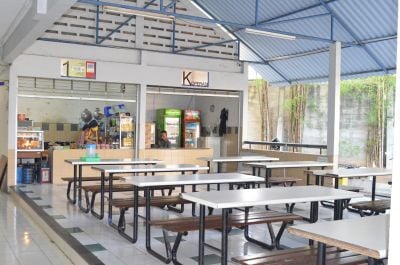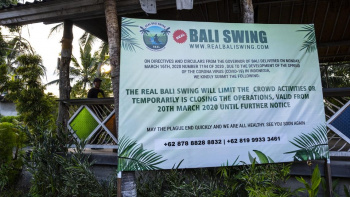An Archipelelago in the Ocean of Corona Part 2
- Title
- An Archipelelago in the Ocean of Corona Part 2
- Year
- Related Places
- Writer(s)
- Photographer(s)
- Reference
- http://ubudnowandthen.com/archipelago-ocean-corona-part-2/
- Photo Credit
- Video Credit
Description
In English
But in yet another surprising move, the president’s chief advisor, Coordinating Minister for Maritime and Investment Affairs, Luhut Binsar Pandjaitan yesterday suddenly hinted that it’s still possible that there will be a ban issued next week. Then, hard on the heels of that, in a Kafkaesque twist, Luhut announced an initiative to lure tourists from China, S Korea and Japan to come to Bali. Extraordinary.
A couple of surveys sampling some 3,853 people in Jakarta showed that roughly 50% were not going home; for the 43% who were going, one of the big factors was that they had lost their jobs. The survey seems to indicate that should the ban be enacted there would be a lot less resistance than previously expected. But it also points to the pressing issue of the need for an integral, possibly longer term, multi-level welfare program for the millions of Indonesian families who subsist on daily wages and the like.
In Bali, on their own initiative several banjar communities have already started handouts. Amounts vary, and ongoing schedules are sketchy. While for most Balinese things haven’t really hit critical point yet, most community members showed a lot of enthusiasm for the hand outs of staple foods, mainly rice, eggs and oil which in fact are still reasonably easy to procure for now. How things will roll out on this front should things get more difficult has yet to be seen.
Indeed compared to Jakarta’s numbers, the official task force’s numbers of infections and deaths in Bali are suspiciously low and almost stagnant. Given the scarcity of testing, the lack of accurate data, and general lack of competent, comprehensive surveys (indeed this applies across the archipelago) it’s hardly surprising. So much so that many serious observers and epidemiologists tend to disregard the official numbers.
A recent article in the Asia Timesfor which I was interviewed was somewhat unfortunately titled “Bali’s mysterious Immunity to Covid-19”. While not suggesting that Bali actually is immune to the disease, the author also doesn’t go into much in-depth exploration of what could be the causes for the unusually low numbers. The author, John McBeth is a senior and seasoned journalist was clearly is being cautious in his assessment. However a combination of a somewhat cursory look at the situation in Bali and a brief mention of the role of dengue (there have been outbreaks in heavily populated areas such as Ubud) that doctors, mine included, have pointed to, explaining that ‘false dengue’ has been known to camouflage covid-19. were left largely unexplored.
The outbreak of dengue in Ubud is interesting in that there was a very high concentration of dengue at first in central Ubud where dance performances for tourists had still continued until close to the outbreak. From there it spread out to neighboring households, which is not so typical of dengue. Dengue tends to follow mosquito infestations that depend on bodies of stagnant water rather than radiating out from a central point. Yet if indeed this was a false dengue alias covert covid contagion, it is now difficult to know as to my knowledge no testing was done.These are of course speculations, but it is possible for such scenarios to have taken place wherever there have been dengue outbreaks. Once again, it is unfortunate that the lack of aggressive tracing and testing has left us with little to work with.
Aside from the general factors I mentioned previously, one needs to take into consideration the fact that with public hospitals already struggling to maintain good hygiene protocol due to lack of protective gear, many people are reluctant to go and get tested in case they actually end up getting infected there. It is only in the last week or so that rapid testing kits are being made available outside of Sanglah public hospital in Denpasar.
Another factor is stigma. Some banjars have aggressively locked down after suspected cases came to light, and one doctor treating a foreign patient with an unrelated disease in Payangan had to deal with the head of the banjar bursting in as he was in consultation with the patient, demanding to know if it was covid-19, and that if it was the patient should be removed immediately. There is little education on the methods and benefits of self-quarantine for non-extreme cases for which hospitals have little to offer. I would bet that locals would do their utmost not to be sent off to some government quarantine away from home. Anything akin to banishment from their community is extremely heavy for Balinese.
Meanwhile the sense of false security (or immunity for that matter) continues to undermine important social distancing efforts. Many people are seemingly heedless of the fact that some 50% of people infected are asymptomatic – which doesn’t stop them being carriers of the contagion. The other day on my way to check on the farm in a beeline there and back, during which I never got closer than 2 meters from anyone local or foreign, I often found myself the only person wearing a facemask. I saw expats jogging without masks, I also saw mask-less locals gathered in groups chatting in villages.
Yet we have reported cases popping up of returning migrant workers, mostly from cruise ships, who have turned out to be infected. For example one was officially confirmed last week in Karangasem, and on Tuesday 14thApril a recent case in Petulu, Ubud was also confirmed – a returning cruise ship worker infected his uncle. Unfortunately the lack of quarantine discipline on the part of some of these returnees has forced the government’s hands, and they are now automatically held in designated quarantine quarters upon arrival.
As of 3 days ago, the official number of these returning workers was somewhere around 6,500 of the 22,000 known to have worked abroad. There is no question that we are well past infections from the travel vector and are well into the phase of community transmission. One trusted source in a village in central Bali informed me that there have been a number of cases that bear all the hallmarks of covid-19 there, and that it has been going around for a few weeks. This is of course anecdotal but the symptoms described fit the bill. I wouldn’t be surprised if this has been repeated elsewhere but the fear of stigmatization has quashed the news.
On the other hand some banjars are playing a heavy hand: Br Sumampan apparently has been on total lockdown for weeks, and for the moment it is indefinite. In their defense they have quite a number of returnees from the cruise ships. But some of the measures seem quite draconian, for example foreigners are not allowed to leave their dwellings under any circumstance except for health reasons.
There are a variety of interpretations of the government guidelines for social distancing. Down in the Canggu area expats have organized parties, in other places local people gather at popular eating-places. On the other hand in some banjars including Nyuhkuning, which has a large expat population, people are only allowed to enter on case-to-case basis after being questioned at the entrance roads.
One of my local informants familiar with the Bali task force suggests there is some kind of resistance on the part of the health department to sharing their data. This seems a bit extreme given the fact they are part of the task force as well. However it is interesting to note that it is only in the last couple of days that more detailed data is being released, partly because of a directive from the central government that has final say on the release of confirmed cases, whose tests are confirmed in the capital. It is certainly not a free flow. Which really is a little unnerving, given that an effective, scientific response is necessarily based on reliable data.
Meanwhile on the 13thof this month the Governor of Bali announced that he would not be requesting permission for lockdown in Bali “as the numbers are so low, and local transmission is negligible”. It would not be remiss to say that he made light of the request to apply to the Ministry of Health in Jakarta for a greenlight to lockdown. In this context, it’s a bit ironic to note that last night local men in Candi Dasa nearly rioted in protest of a local hotel being used as quarantine facility for returning migrant workers.
Given this state of affairs, and the fact that this pandemic has repeatedly followed a similar pattern nearly everywhere whereby on a graphic it seems to be reasonably flat until it suddenly spikes sharply, we can expect things to change radically at a given moment. If Indonesia’s intelligence body BIN has their modeling right, this could be as late as end of June – around the time people would be coming back to work after mudik. So far their projection for number of cases at the end of March has been 99% accurate. Interestingly the BIN report says their timeline projection could be shortened if adequate preventative measures were carried out.
In most scenarios we have seen around the world, as the numbers spike, deaths then start to increase dramatically and continue to rise until they plateau weeks later. However this is not necessarily a doomsday scenario. As Nobel Laureate MichaelLevitt has pointed out, given good social discipline, the worst can pass in much less time than some of the predicted months or even years. He accurately predicted the ending of China’s outbreak, and the number of deaths to within single digits. I quote: “Levitt says the data simply don’t support such a dire scenario — especially in areas where reasonable social distancing measures are in place.”.
We are better off knowing than being kept in the dark, intentionally or not.In Balinese



Enable comment auto-refresher